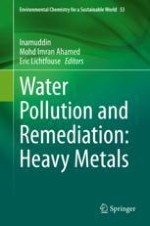2021 | OriginalPaper | Chapter
13. Heavy Metal Removal from Wastewater Using Adsorbents
Authors : Reena Malik, Bhaskaran, Meena, Suman Lata
Published in: Water Pollution and Remediation: Heavy Metals
Publisher: Springer International Publishing
Activate our intelligent search to find suitable subject content or patents.
Select sections of text to find matching patents with Artificial Intelligence. powered by
Select sections of text to find additional relevant content using AI-assisted search. powered by
